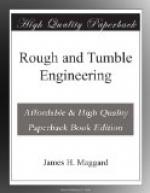If the trouble is not in the stuffing box, go to the tank and see if there is anything over the screen or strainer at the end of the hose. If there is not, take hold of the hose and you can tell if there is any suction. Then ascertain if the water flows in and then out of the hose again. You can tell this by holding your hand loosely over the end of the hose. If you find that it draws the water in and then forces it out again, the trouble is with the first check valve. There is something under it which prevents its shutting down. If, however, you find that there is no suction at the end of hose examine the second check. If there should be something under it, it would prevent the pump working, because the pump forces the water through it; and, as the plunger starts back, if the check fails to hold, the water flows back and fills the pump barrel again and there would be no suction.
The trouble may, however, be in the hot water check, and it can always be told whether it is in the second check or hot water check by opening the little drain cock. If the water which goes out through it is cold, the trouble is in the second check; but, if hot water and steam are blown out through this little drain cock, the trouble is in the hot water check, or the one next to the boiler. This check must never be tampered with without first turning the stop cock between this check and the boiler. The valve can then be taken out and the obstruction removed. Be very careful never to take out the hot water check without closing the stop cock, for if you do you will get badly scalded; and never start the pump without opening this valve, for if you do, it will burst the pump.
The obstruction under the valves is sometimes hard to find. A young man in southern Iowa got badly fooled by a little pebble about the size of a pea, which got into the pipe, and when he started his pump the pebble would be forced up under the check and let the water back. When he took the check out the pebble was not there, for it had dropped back into the pipe. You will see that it is necessary to make a careful examinations and not get mad, pick up a wrench and whack away at the check valve, bruising it so that it will not work. Remember that it would work if it could, and make up your mind to find out why, it don’t work. A few years ago I was called several miles to see an engine on which the pump would not work. The engine had been idle for two days and the engineer had been trying all that time to make the pump work. I took the cap off of the horizontal check, just forward of the pump barrel, and took the valve out and discovered that the check was reversed. I told the engineer that if he would put the check in so that the water could get through, he would have no more trouble. This fellow had lost his head. He was completely rattled. He insisted that “the valve had always been on that way,” although the engine had been run two years.




